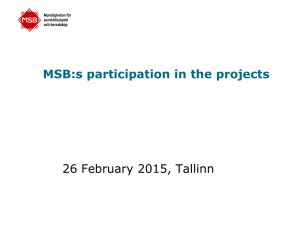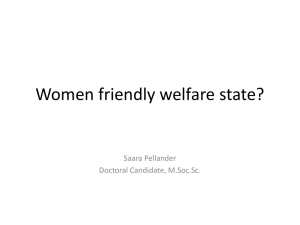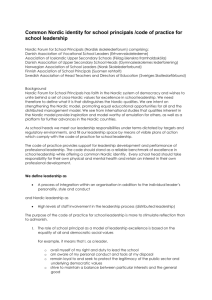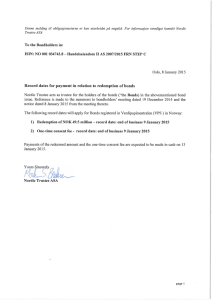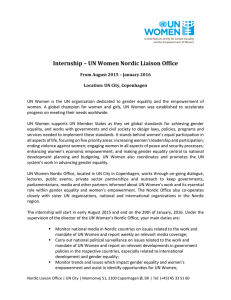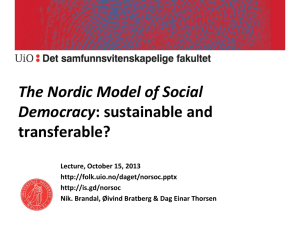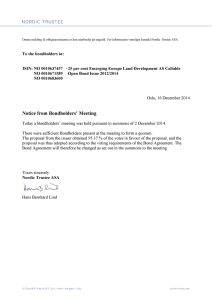Principles and Instruments
advertisement
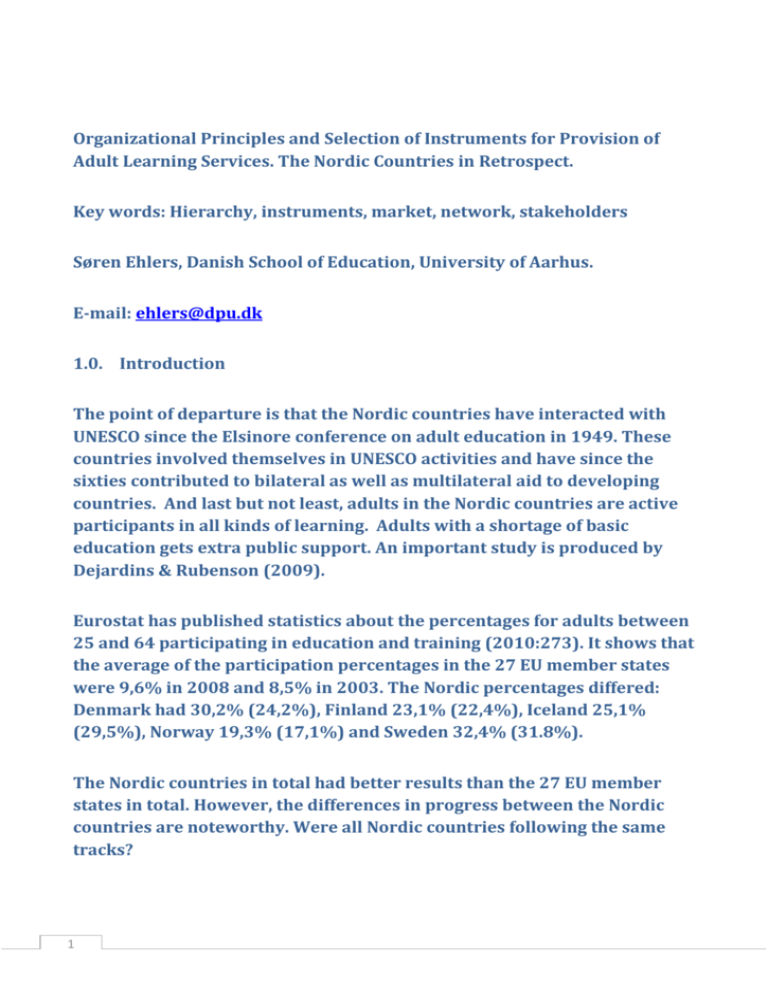
Organizational Principles and Selection of Instruments for Provision of Adult Learning Services. The Nordic Countries in Retrospect. Key words: Hierarchy, instruments, market, network, stakeholders Søren Ehlers, Danish School of Education, University of Aarhus. E-mail: ehlers@dpu.dk 1.0. Introduction The point of departure is that the Nordic countries have interacted with UNESCO since the Elsinore conference on adult education in 1949. These countries involved themselves in UNESCO activities and have since the sixties contributed to bilateral as well as multilateral aid to developing countries. And last but not least, adults in the Nordic countries are active participants in all kinds of learning. Adults with a shortage of basic education gets extra public support. An important study is produced by Dejardins & Rubenson (2009). Eurostat has published statistics about the percentages for adults between 25 and 64 participating in education and training (2010:273). It shows that the average of the participation percentages in the 27 EU member states were 9,6% in 2008 and 8,5% in 2003. The Nordic percentages differed: Denmark had 30,2% (24,2%), Finland 23,1% (22,4%), Iceland 25,1% (29,5%), Norway 19,3% (17,1%) and Sweden 32,4% (31.8%). The Nordic countries in total had better results than the 27 EU member states in total. However, the differences in progress between the Nordic countries are noteworthy. Were all Nordic countries following the same tracks? 1 All five Nordic countries interact with Nordic Council of Ministers. This institution established in 1971 was originally designed with the Council of Ministers in the European Economic Community (EEC) as model. Denmark joined the EEC in 1973 and Finland and Sweden became EU member states in 1996. Iceland and Norway have been associated the EEC/ EU since 1973. EEC had no legitimacy in education policy making: The legitimacy came in force in 1993 due to the passing of the Maastricht Treaty. Nordic cooperation within adult education is much older than the Nordic Council of Ministers and was a century back based on transnational cooperation between NGOs. This kind of cooperation was subsidized by the Nordic governments and they categorized the activity as culture policy. A budget line for education/training of adults within Nordic Council of Ministers came in 1982 and a special Nordic committee of government officials was appointed in 1984. These officials developed Nordic action plans for the area and published in 1988 an action plan which said 1) that that lifelong learning should be the common Nordic perspective for all education policies and stated 2) that competence development was one of the most important tasks for the Nordic countries (Nordisk Ministerråd 1988). A think tank manned with Nordic experts within the policy area was established in 1992 and Nordic Council of Ministers was in 1995 able to publish a policy paper called “Golden Riches in the Grass. Lifelong Learning for all”. A Nordic policy paper based on the lifelong learning perspective was a reality before the Maastricht Treaty came into force. In 1996, when Finland and Sweden became EU member states was the European Commission marketing the lifelong learning concept through Year of Lifelong Learning. Education as such was from 1995 defined as a service because of the General Agreement on Trade in Services (GATS). 1.1. Three organizational principles 2 This paper uses a political science approach because it is assumed that implementation theory (Winther 2006) may make studies of Nordic policy making fruitful for other regions in the world. Political scientists are operating with two policy making processes: 1) the formulation process and 2) the implementation process and they agree in saying that stakeholders usually interact with government in both processes. A Government will usually before a reform is passed by the Parliament develop a policy design which includes the selection of instruments for the implementation process (May 2006). These instruments are often called a package when they are presented to the Parliament. The Government will adjust them to the ruling organizational principle in the policy area in question. The main organizational principles for the implementation process are according to Winther & Lehmann Nielsen (2010): 1) Hierarchy, 2) Market, and 3) Network. 1) Hierarchy as organizational principle: A public authority (national, regional, or local level) may organize itself in relation to two task: - The production of adult learning services (the 19 counties and the 430 municipalities in Norway are providers themselves) - The regulation of adult learning services (the Norwegian government is guiding the counties and the municipalities ) 2) Market as organizational principle: 3 A public authority (national, regional, or local level) may pay providers subsidies for their production of adult learning services. These providers may be non-profit or profit organizations (the 284 Swedish municipalities have since 1992 been contracting with both kind of partners). 3) Network as organizational principle: A number of public authorities (national, regional, or local level) may interact with stakeholders (corporativism): - On national level (The Council for Lifelong Learning in Finland consists of stake holders and includes the national organizations for providers and learners) - On regional level (the Norwegian counties implement Validation of Prior Learning in cooperation with regional stakeholders) - On local level (some of the Swedish municipalities are establishing Public Private Partnerships) 1.2. Three Instruments for the Implementation Process. Political scientists disagree about the number of instruments in an implementation process. Salamon (2002, referred in: Winther & Lehmann Nielsen 2010) involved 14 different instruments in his studies. However, this study operates for the sake of simplicity with three instruments. The following definition is provided by Bemelmanns-Videc, Rist & Vedung (1998): Policy instruments are the set of techniques by which government authorities wield their power in attempting to ensure support and effect or prevent social change. 4 These authors are dividing the instruments relevant for the implementation process into: 1) Regulations, 2) Economic Means, and 3) Information. 1) Regulations as instruments for implementation: Regulations may have much effect if the country has developed a professional staff of civil servants (The Norwegian bureaucrats on national level is working within three organizations: The Ministry (Department is the name), the Directorate and the Agency (Vox is the name). 2) Economic Means as instruments for implementation: Subsidies (national, regional and local level) may be distributed in ways which support the implementation process (Denmark prefers the taximeter system where public funding is calculated on the basis of credits earned by the individual learner. The general credit tool in EU member states is European Credit Transfer System (ECTS)). 3) Information as an instrument for implementation: Barrieres during the implementation process may be ignorance or lack of commitment among street level bureaucrats (However, information may also be needed by the potential adult learners. The Finnish system for Guidance and Counselling is much appreciated). 1.3. Nordic policy making before 1991. 5 The Nordic countries formulated the first national strategies for the education/training of adults with reference to the discussions at the UNESCO world conferences in Montreal (1960) and in Tokyo (1972) and in the development of the policy area were the Nordic countries following tracks that were similar to each other. The Danish Government delivered a in December 1972 a presentation during the first regular parliamentary debate about the education/training of adults which demonstrated the influence of the Tokyo negotiations. The Government promised the Parliament to formulate a national strategy and the formulation process lasted more than a decade (Ehlers 2009). Other Nordic countries acted faster and the Norwegian Parliament passed a reform in 1976 and struggled afterwards with the implementation process. Nordic policy formulation was in the seventies influenced by guidelines provided through UNESCO. The Danish strategy passed by Parliament in May 1984 contained a catalogue of guidelines which referred to the formulation of policies for a national infrastructure consisting of: 1) folkeoplysning (non- formal adult education delivered by NGOs), 2) general education (formal adult education delivered by providers under the Ministry of Education) and 3) vocational education/training (formal and non-formal adult education delivered by providers under the Ministry of Labour). The first sector was a well established network of independent providers belonging to the voluntary sector. The two other sectors were public and established in the sixties. These categories were used by all Nordic governments and the main reason seems to be that the five countries coordinated their policy formulation through Nordic Council of Ministers. The dominant organizational principle in the eighties was Hierarchy in Finland, Norway and Sweden. Denmark used Network (because of the tradition for decentralization) and Iceland Market. This paper researches implementation processes between 1991 and 2010 and examines the two decades one by one, country by country. 6 1.4. Research question 1: Which organizational principle dominated the provision of adult learning services 1991-2000 and 2001-2010? 1.5. Research question 2: Which instruments for dominated the implementation processes 1991-2000 and 2001-2010? 2.0. First decade Educational policy making between 1991 and 2000 was influenced by the changes in Europe which was caused by the collapse of the Sovjet Union. The European Commission prepared a long term competition with the US economy and developed an active employment policy. The governments in Finland, Norway and Sweden wanted their countries to become EU member states but the Norwegian government did not get majority in the national referendum of 1992. Educational policy formulation in the Nordic countries has since the sixties relied upon OECD recommendations (recurrent education was originally a Swedish policy) and the close relation to OECD is apparent in the nineties as well. The policy formulating Nordic think tank (1992-1995) followed OECD guidelines. 2.1. Denmark The estimate for the decade as such is that the ruling organizational instrument was Network. 7 High unemployment was a major problem in the early nineties and a coalition government (Socialdemocratic/Social-Liberal) transformed in 1993 the Danish labour market policy into active employment policy which caused an expansion of the production of adult learning services. A government strategy announced in 1995 that adult learning would become a priority for providers within vocational education and higher education. The Parliament passed in 2000 a reform called The System for Further Education for Adults which led to the design of a framework for the provision of formal adult learning services (all levels) which functions as a parallel to the ordinary system organized for young learners (under 25 years). The sector for non-formal adult learning organized by NGOs was cut down. The dominant instrument for implementation in Denmark was Economic Means combined with Information. 2.2. Finland The estimate for the decade as such is that the ruling organizational principle was Market. Finland was deeply hit by recession when the Russian market disappeared and the unemployment percent went up. The crisis led to the establishment of a broad coalition government and to a long term pact between the social partners on the labour market (Elvander 2002). The Finnish providers organized as NGOs competed with public and private providers and offered vocational training (Rinne & Vantaja 2000). The dominant instrument for implementation was in Finland Economic Means combined with Regulations. 2.3. Iceland 8 The estimate for the decade as such is that the ruling organizational principle was Market. The Icelandic Government followed the general Nordic pattern from the eighties during the formulation of policies for the education/training of adults. However, two reforms passed by Parliament in 1992 were newer implemented by the Icelandic Government. The economic climate was changing. The dominant instrument for implementation in Iceland was Information combined with Regulations. The Government was reluctant towards Economic Means. 2.4. Norway The estimate for the decade as such is that the ruling organizational principle was Hierarchy. The national curriculum for adults was abolished in 1994. The public guidelines for adult learning was afterwards based on learning outcomes and identical with the guidelines for children (municipality provision) and young people (county provision). The Norwegian union of employees took an adult learning initiative in 1993 and was in 1994 supported by the association of employers. This led in 1999 to a decision in Parliament which forced the Government to establish a national development project called the Competence Reform (Payne 2006). The dominant instrument for implementation in Norway was Regulations combined with Information. 2.5. Sweden 9 The estimate for the decade as such is that the ruling organizational principle was Market. A reform decentralized the educational system in total and the Swedish government began in 1992 to provide the municipalities with general educational block grants. One consequence of this move was a deregulation of the adult learning services: The national curriculum for the education/training of adults (established in 1982) was abolished in 1994. Another consequence was that the public labour market education (the AMU system) was reorganized in 1993 as a joint stock-holder company (Lumsden Wass 2004). An important factor was the unemployment crisis. This led the Swedish government to establish a development project called the Knowledge Lift (1997-2002) which provided benefits to adult learners with limited educational luggage. The dominant instrument for implementation in Sweden was Economic Means combined with Information. 2.6. Summary Denmark, Finland and Sweden were hit by unemployment. However, Denmark kept Network as the ruling organizational principle while Finland and Sweden moved from Hierarchy to Market. Economic Means were in the nineties the dominant instrument for implementation processes in Denmark, Finland and Sweden. 3.0. Second decade 10 The EU had announced the Lisbon strategy in 2000 but the aim to become the most competive knowledge economy in the world by 2010 was not reached for several reasons. One of them was that the EU suddenly expanded into 27 member states – another the financial crisis (Pepin 2011). However, the Lisbon strategy included the work programme Education and Training 2010 which had influence on the formulation of policies for adult learning services in the neighboring countries which wanted to become EU member states. They tried to include the concept of lifelong learning into their policy formulation (Kleibrink 2011). OECD staff visited the Nordic countries and published between 2000 and 2003 a number of informative reports which are detailed studies of the national policies and practices. 3.1. Denmark The estimate for the decade as such is that the ruling organizational principle was Market. A coalition government (Liberal/Conservative) reorganized the national coordination of adult learning services which meant that the administration of the labour market training (the AMU-system) was moved from the Ministry of Employment (new name) to the Ministry of Education. The Directorate for adult learning (established in 1982) disappeared and the market forces began to rule. The dominant instrument for implementation was in Denmark Economic Means combined with Information. 3.2. Finland 11 The estimate for the decade as such is that the ruling organizational principle was Market. The Finnish governments were following OECD guidelines carefully and the OECD review about the Finnish provision of adult learning services praises the government decisions. Finland has no EU skepticism at all. The dominant instrument for implementation was in Finland Economic Means combined with Regulation. 3.3. Iceland The estimate for the decade as such is that the ruling organizational principle was Market. However, the Icelandic government decided in 2003 to expand the national funding of adult learning services and left the distribution of funding to a newly established non-public body (called FA) owned by the social partners. FA became the developer of Icelandic Guidance and Counselling. The dominant instrument for implementation was in Iceland Economic Means combined with Information. 3.4. Norway The estimate for the decade as such is that the ruling organizational principle as such was Hierarchy. However, the Norwegian government had decided to establish a national development project and expanded in 2001 the state bureaucracy with a public agency (called Vox). Vox coordinated the national efforts with the Competence Reform. The Government expanded the national funding of adult learning services. 12 The dominant instrument for implementation was in Norway Economic Means combined with Regulations. 3.5. Sweden The estimate for the decade as such is that the ruling organizational principle was Market. Sweden kept the decentralization and the deregulation strategies and was reluctant towards EU guidelines (Dahl 2003). A study of educational policy making is not mentioning EU at all (Marton 2008). The dominant instrument for implementation was in Sweden Economic Means combined with Information. 3.6. Summary Market had become the dominating organizational principle in four Nordic countries. Norway and Iceland are not EU member states (Iceland has applied for membership after the financial crisis) and did not change their dominant organizational principle. All Nordic countries preferred 2000 to 2010 Economic Means as the dominant instrument for implementation. All countries were trying to involve the social partners in implementation processes. 4. 0. Discussion What caused these changes? The best explanation is probably the influence of economic movements in the world around the Nordic countries. The Nordic countries are small open economies and the globalization process makes the number of options limited. 13 Education was in 1995 (GAT) defined as service. The Nordic countries want to influence the provision of such services and their active support to adults with educational shortage makes one instrument more relevant than others. This instrument is Economic Means. 5.0 Conclusion. The study has tried to show how the Nordic countries have been able to give the expansion of adult learning services high priority because the governments were willing to change their ruling organizational principles or to revise their selection of instruments for implementation. 5.1. Perspectives One hypothesis for policy making in the decade 2011-2020 is that most of the Nordic countries will change their dominant organizational principle because they want to make sure that everybody on the labour market is involved in adult learning. Market as the ruling organizational principle makes the production flexible but the provision of adult learning services at regional and local level may become unstable. More coordination will be needed and it seems as if some Nordic countries want to decentralize the coordination tasks. New models on the regional level will be attractive. The dominant organizational principle in the Nordic countries will probably be Network. Another hypothesis is that the Nordic countries will cling to Economic Means as the dominant instrument for their implementation processes. The five countries are investing much in the production of adult learning services and the public subsidies may be used strategically for the regulation of provision on regional and local level. The second dominant instrument will probably be Information. IKT has a huge potential. 6.0. Reports and policy papers 14 Ehlers, S. (2010), Nordic arguments for lifelong learning. Policy making 1960-2000. København: Nationalt Center for Kompetenceudvikling. (Not published). Eurostat (2010), Europe in figures – Eurostat Yearbook. Luxembourg: Publications Office of the European Union. Nordic Council of Ministers (1995), Golden Riches in the Grass. Lifelong learning for all. Copenhagen: Nordic Council of Ministers. Nordisk Ministerråd (1988), Handleplan for nordisk kulturelt samarbejde. København: Nordisk Ministerråd. Nordisk Ministerråd (1997), Folkbildning och vuxenundervisning i Norden. Struktur – omfang – ekonomi. Stockholm: Tema Nord. Nordisk Ministerråd (2000), Nordisk løft for voksnes læring. København: Nordisk ministerråd. 7.0. Research literature Bemelmanns-Videc, M.-L., R. C. Rist & E. Vedung (1998) (Eds.), Carrots, Sticks & Sermons. Policy Instruments and their Evaluation. New Brunswick and London: Transaction Publishers. Dahl, B. (2003), The Impact of EU Education and Training Policies in Sweden. In: Implementing European Union Education and Training Policy. A Comparative Study of Issues in Four Member States. Dorecht: Kluwer Academic Publishers. Dejardins, R. & K. Rubenson (2009), The Impact of Welfare Regimes on Barriers to Participation. In: Adult Education Quarterly. Vol. 59. No. 3. 15 Ehlers, S. (2009), Livslang læring som politisk strategi i 1900-tallets Danmark. In: Uddannelseshistorie 2009. København: Selskabet for Skoleog Uddannelseshistorie. Elvander, N. (2202), The Labour Market Regimes in the Nordic Countries, A Comparative Analysis. In: Scandinavian Political Studies. Vol. 25. No. 2. Engesbak, H. & T.A. Stubbe (2008), Bureaucratic response to policy change: implementation of adult education policy in Norway. In: International Journal of Lifelong Education. Vol. 27, No. 1. Holford, J. et al. (2008), Patterns of Lifelong Learning. Policy and Practice in an Expanding Europe. New Brunswick: Transaction Publishers. Jakobsson, E. (2007), Mot en ny vuxenutbildningspolitik? Regional utveckling som policy och praktik. Linkøping: Linkøpings Universitet. Kleibrink, A. (2011), The EU as a Norm Entrepreneur: the case of lifelong learning. In: European Journal of Education: Vol. 46. No. 1. Lumsden Wass, K. (2004), Vuxenutbildning i omvandling. Kunskapslyftet som en satt att organisera fornyelse. Gøteborg: Acta Universitatis Gothoburgensis. Marton, S. (2006), Education policy. In: Handbook of Public Policy. London: Sage Publications. May, P.J. (2006), Policy Design and Implementation. In: Handbook of Public Policy. London: Sage Publications. Pepin, L. (2011), Education in the Lisbon Strategy: assessment and prospects. In: European Journal of Education. Vol. 46. No. 1. 16 Payne, J. (2006), The Norwegian competence reform and the limits of lifelong learning. In: International Journal of Lifelong Education. Vol. 25. No. 5. Rinne, R. & M. Vanttaja (2000), New Directions of Adult Education Policy in Finland. In: Reform and Policy. Adult Education Research in Nordic Countries. Trondheim: Tapir Academic Press. Rubenson, K. (1994), Adult Education Policy in Sweden 1967-1991. In: Review of Policy Research. Vol. 13. No. 3-4. Tøsse, S. (2006), Lifelong Learning and New Competence. The Reasoning behind the Norwegian Adult Education Reform Policy in the 1980s and 1990s. In: Milestones towards lifelong learning systems. Copenhagen: Danish Education University Press. Winther, S.C. (2006), Implementation. In: Handbook of Public Policy. London: Sage Publications. Winther, S.C. & Lehmann Nielsen, V. (2010), Implementering af politik. Aarhus: Academica. 17
